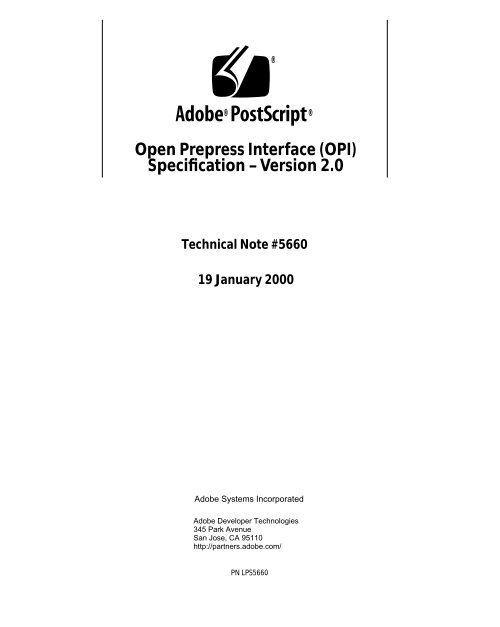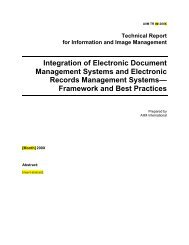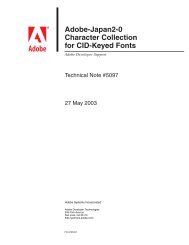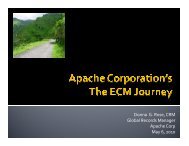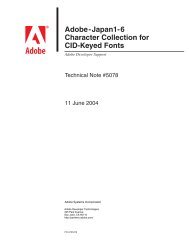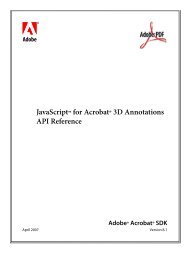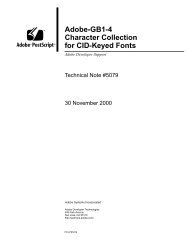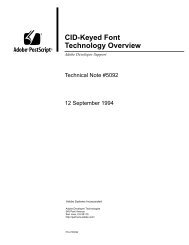Open Prepress Interface (OPI) Specification ... - Adobe Partners
Open Prepress Interface (OPI) Specification ... - Adobe Partners
Open Prepress Interface (OPI) Specification ... - Adobe Partners
Create successful ePaper yourself
Turn your PDF publications into a flip-book with our unique Google optimized e-Paper software.
®<br />
® ®<br />
<strong>Open</strong> <strong>Prepress</strong> <strong>Interface</strong> (<strong>OPI</strong>)<br />
<strong>Specification</strong> – Version 2.0<br />
Technical Note #5660<br />
19 January 2000<br />
<strong>Adobe</strong> Systems Incorporated<br />
<strong>Adobe</strong> Developer Technologies<br />
345 Park Avenue<br />
San Jose, CA 95110<br />
http://partners.adobe.com/<br />
PN LPS5660
Copyright © 1984–86, 1992, 1995, 1998–99 <strong>Adobe</strong> Systems Incorporated. All rights reserved.<br />
NOTICE: All information contained herein is the property of <strong>Adobe</strong> Systems Incorporated.<br />
No part of this publication (whether in hardcopy or electronic form) may be reproduced or<br />
transmitted, in any form or by any means, electronic, mechanical, photocopying, recording, or<br />
otherwise, without the prior written consent of the publisher.<br />
PostScript is a registered trademark of <strong>Adobe</strong> Systems Incorporated. All instances of the name<br />
PostScript in the text are references to the PostScript language as defined by <strong>Adobe</strong> Systems<br />
Incorporated unless otherwise stated. The name PostScript also is used as a product trademark for<br />
<strong>Adobe</strong> Systems’ implementation of the PostScript language interpreter.<br />
Except as otherwise stated, any reference to a “PostScript printing device,” “PostScript display<br />
device,” or similar item refers to a printing device, display device or item (respectively) which<br />
contains PostScript technology created or licensed by <strong>Adobe</strong> Systems Incorporated and not to<br />
devices or items which purport to be merely compatible.<br />
<strong>Adobe</strong>, PostScript, PostScript 3, and the PostScript logo are trademarks of <strong>Adobe</strong> Systems<br />
Incorporated. All other trademarks are the property of their respective owners.<br />
This publication and the information herein is furnished AS IS, is subject to change without<br />
notice, and should not be construed as a commitment by <strong>Adobe</strong> Systems Incorporated. <strong>Adobe</strong><br />
Systems Incorporated assumes no responsibility or liability for any errors or inaccuracies, makes<br />
no warranty of any kind (express, implied, or statutory) with respect to this publication, and<br />
expressly disclaims any and all warranties of merchantability, fitness for particular purposes,<br />
and noninfringement of third party rights.
iii<br />
Contents<br />
<strong>Open</strong> <strong>Prepress</strong> <strong>Interface</strong> (<strong>OPI</strong>) Version 2.0 5<br />
1 Introduction 5<br />
1.1 Differences from <strong>OPI</strong> 1.3 5<br />
1.2 Terminology 5<br />
1.3 References 7<br />
2 <strong>OPI</strong> 2.0 Comments 7<br />
%%Begin<strong>OPI</strong>:2.0 7<br />
%%Distilled(no keywords) 7<br />
%%ImageFileName: 8<br />
%%MainImage: 8<br />
%%TIFFASCIITag: 9<br />
%%ImageDimensions: 10<br />
%%ImageCropRect: 10<br />
%%ImageOverprint: false | true 11<br />
%%ImageInks: <br />
... 12<br />
14<br />
%%BeginIncludedImage(no keywords) 15<br />
%%IncludedImageDimensions: 15<br />
%%IncludedImageQuality: 16<br />
17<br />
%%EndIncludedImage(no keywords) 18<br />
%%End<strong>OPI</strong>(no keywords) 18<br />
19 JANUARY 2000
iv<br />
Contents<br />
3 Requirements for <strong>OPI</strong> Producers 18<br />
Color Separation Conventions 18<br />
Prepare the graphics state 19<br />
<strong>OPI</strong> 2.0 versus <strong>OPI</strong> 1.X 19<br />
Composite versus separated PostScript language streams 20<br />
4 Requirements for <strong>OPI</strong> Consumers 21<br />
<strong>OPI</strong> 2.0 versus <strong>OPI</strong> 1.X 21<br />
Workflow position 21<br />
Ignore unknown comments 22<br />
Special operators 22<br />
5 Examples 23<br />
5.1 Example 1 23<br />
5.2 Example 2 24<br />
6 Design and Usage 25<br />
6.1 Design Requirements 25<br />
6.2 Workflow Options 26<br />
Option 1 26<br />
Option 2 27<br />
7 Reading from a named file 27<br />
8 Change History 28<br />
19 JANUARY 2000
5<br />
<strong>Open</strong> <strong>Prepress</strong> <strong>Interface</strong><br />
(<strong>OPI</strong>) Version 2.0<br />
1 Introduction<br />
The <strong>Open</strong> <strong>Prepress</strong> <strong>Interface</strong> (<strong>OPI</strong>) is a collection of PostScript® language<br />
conventions that allow low-resolution proxy images to be used for page layout.<br />
The high-resolution versions of the images are automatically substituted later by<br />
the image substitution server. Both desktop applications and electronic prepress<br />
systems can use <strong>OPI</strong> to minimize network traffic and image storage requirements.<br />
PostScript language files containing <strong>OPI</strong> 2.0 comments must adhere to the<br />
Document Structuring Conventions, version 3.0 or later. See Appendix G,<br />
“Document Structuring Conventions—Version 3.0,” in the PostScript Language<br />
Reference Manual, Second Edition, or <strong>Adobe</strong> Technical Note #5001, Document<br />
Structuring Conventions, Version 3.0. In this specification, the abbreviation “DSC”<br />
is used to refer to the Document Structuring Conventions.<br />
The Backus-Naur form (BNF) of notation, used in the DSC 3.0 document, is also<br />
used in this specification.<br />
1.1 Differences from <strong>OPI</strong> 1.3<br />
<strong>OPI</strong> 2.0 introduces the need for the <strong>OPI</strong> producer to establish the graphics state.<br />
For information on setting the graphics state, see “” on<br />
page 14.<br />
The other major difference from <strong>OPI</strong> 1.3 is the requirement for the comments to<br />
appear in a specific order. Section 2, “<strong>OPI</strong> 2.0 Comments,” lists all comments in<br />
the order in which they must appear in a document. Additional differences are list<br />
in section 8, “Change History.”<br />
1.2 Terminology<br />
Bitmap: A 1-bit deep image, typically specified using the PostScript operator<br />
imagemask.<br />
19 JANUARY 2000
6 Section 1: Introduction<br />
Elementary DSC data type: An elementary or base type is a terminating<br />
expression that does not reference any other tokens and is considered to be a base<br />
on which other expressions are built. See Technical Note #5001, “PostScript<br />
Language Document Structuring Conventions <strong>Specification</strong>, Version 3.0.”<br />
Grayscale image: A monochrome image that is deeper than 1 bit per pixel<br />
(typically 8 bits).<br />
Main image: The high-resolution version of the image, as it was scanned or<br />
otherwise acquired, from which the proxy image is created.<br />
<strong>OPI</strong>: for the purpose of this document, “<strong>OPI</strong>” will only refer to the PostScript<br />
language convention associated with <strong>Adobe</strong> <strong>OPI</strong> version 1.3 and <strong>Adobe</strong> <strong>OPI</strong><br />
version 2.0.<br />
<strong>OPI</strong> Producer: An application that writes <strong>OPI</strong> comments—typically, a page<br />
layout program such as <strong>Adobe</strong>® InDesign or <strong>Adobe</strong> PageMaker® Plus.<br />
<strong>OPI</strong> Consumer: An application that reads <strong>OPI</strong> comments and (usually) inserts<br />
high-resolution image data into the PostScript language stream. This is typically<br />
an image substitution server, but other prepress applications can also be <strong>OPI</strong><br />
Consumers.<br />
An application can be both an <strong>OPI</strong> Producer and an <strong>OPI</strong> Consumer. <strong>OPI</strong><br />
Consumers should generally also be valid <strong>OPI</strong> Producers if they wish to write out<br />
an altered PostScript language stream, since another <strong>OPI</strong> Consumer may need to<br />
do further processing of the stream. An application should not assume that there<br />
is no other application between it and the imagesetter or platesetter final output,<br />
unless it is absolutely certain that no other application or RIP will post-process the<br />
output.<br />
<strong>OPI</strong> Server: this term is often used to mean a server that resolves an image<br />
substitution method. For the purposes of this document, “image substitution<br />
server” will be used instead.<br />
<strong>OPI</strong> context: Everything between “%%Begin<strong>OPI</strong>: 2.0” and the matching<br />
%%End<strong>OPI</strong> comment, inclusive. <strong>OPI</strong> contexts may be included in EPS files that<br />
may be incorporated into other PostScript language streams.<br />
19 JANUARY 2000
<strong>Open</strong> <strong>Prepress</strong> <strong>Interface</strong> (<strong>OPI</strong>) Version 2.0<br />
7<br />
PDF: Portable Document Format; a format that allows compact representation of<br />
graphics and text, and which is portable across multiple platforms.<br />
Proxy image: The lower-resolution version of the image that is imported into a<br />
page layout program or other <strong>OPI</strong> Producer.<br />
1.3 References<br />
For the following references, all <strong>Adobe</strong> Technical Note documents are available at:<br />
< http://partners.adobe.com/asn/developer/technotes.html ><br />
1. Portable Document Format (PDF) Reference Manual, Version 1.3.<br />
2. PostScript Language Reference, Third Edition, <strong>Adobe</strong> Systems Incorporated.<br />
3. <strong>Adobe</strong> Technical Note #5001, “PostScript Language Document Structuring<br />
Conventions <strong>Specification</strong>, Version 3.0.” The name “Document Structuring<br />
Conventions” is sometimes abbreviated to “DSC.”<br />
4. <strong>Adobe</strong> Technical Note #5620, “Portable Job Ticket Format – Version 1.1.”<br />
5. <strong>Adobe</strong> Technical Note #5044, “Color Separation Conventions for PostScript<br />
Language Programs.”<br />
6. TIFF Revision 6.0, Aldus Corporation, June 3, 1992.<br />
2 <strong>OPI</strong> 2.0 Comments<br />
The following <strong>OPI</strong> comments are listed in the order they must appear in the<br />
file.<br />
%%Begin<strong>OPI</strong>: 2.0<br />
Required. Marks the beginning of an <strong>OPI</strong> 2.0 context.<br />
%%Distilled<br />
(no keywords)<br />
%%Distilled is included in the stream at this point if and only if the original<br />
PostScript language stream was converted into a Portable Document<br />
Format (PDF) file, and then back to a PostScript language stream.<br />
19 JANUARY 2000
8 Section 2: <strong>OPI</strong> 2.0 Comments<br />
An <strong>OPI</strong> Consumer should use this information to reapply color to a<br />
colorized grayscale image, based on the <strong>OPI</strong> color comments, since the<br />
normal automatic color application environment created by the original<br />
<strong>OPI</strong> Producer is disabled when a PostScript code is converted into PDF, and<br />
then back again into PostScript code.<br />
%%ImageFileName:<br />
%%MainImage:<br />
<br />
Required. %%ImageFileName: must be written by an <strong>OPI</strong> 2 Producer for<br />
every image in the stream that may be the target of <strong>OPI</strong> image substitution.<br />
This comment records the full pathname of the low-resolution proxy<br />
image. filename is an elementary DSC type.<br />
The low-resolution proxy image is typically a TIFF or EPS file. (Some<br />
applications require low-resolution proxy images to be TIFF files.)<br />
<br />
::= <br />
Required if the low-resolution if the low-resolution proxy image is a TIFF<br />
file and the ImageID TIFF tag (#32781) exists.<br />
MainImageID is the full pathname of the original, high-resolution file, or<br />
any other identifying string that uniquely identifies the main image. The<br />
MainImageID string is a textline, an elementary DSC type.<br />
Note<br />
The high-resolution image is NOT required to be in TIFF format. It can be<br />
in any format that the <strong>OPI</strong> Consumer wishes to support, including Scitex<br />
CT, PDF, EPS, and Quark Desktop Color Separation (DCS) files.<br />
If the low-resolution proxy image is an EPS file instead of a TIFF file, the ID<br />
of the main image should be stored in a %%MainImage: comment in the<br />
EPS file, typically as part of an <strong>OPI</strong> context in the EPS file.<br />
If the %%MainImage: comment does not exist, an <strong>OPI</strong> Consumer must do<br />
the best it can to find and link to the correct high-resolution image, using<br />
the name given in the %%ImageFileName: comment. If the image does not<br />
exist at the indicated location, the <strong>OPI</strong> Consumer can ask the operator to<br />
help re-link the image or use search path rules that have been set up ahead<br />
of time.<br />
19 JANUARY 2000
<strong>Open</strong> <strong>Prepress</strong> <strong>Interface</strong> (<strong>OPI</strong>) Version 2.0<br />
9<br />
%%TIFFASCIITag:<br />
<br />
::= (TIFF tag number, in decimal)<br />
::= (contents of TIFF field)<br />
An <strong>OPI</strong> 2.0 Producer must write this comment if the low-resolution proxy<br />
image is a TIFF file and if there are ASCII fields in the file. The Producer<br />
writes a separate comment for each TIFF ASCII field.<br />
An <strong>OPI</strong> 2.0 Producer uses this comment convention to pass TIFF ASCII<br />
field values from the proxy image to an <strong>OPI</strong> Consumer.<br />
tagnumber is the TIFF tag number. It is a 5-digit or less decimal number,<br />
and is not padded with zeros or spaces.<br />
Examples:<br />
%%TIFFASCIITag: 270 (Sunrise from Waikiki)<br />
%%TIFFASCIITag: 306 (1995:02:14 13:55:59)<br />
%%TIFFASCIITag: 316 (Apple PowerMac\250 8100)<br />
%%TIFFASCIITag: 33432 (Copyright\251, Carl Stevensen, 1995. All<br />
rights reserved.)<br />
%%TIFFASCIITag: 65535 (First substring.)<br />
%%+ (Second substring.)<br />
The value of %%TIFFASCIITag: is the value of the corresponding TIFF ASCII<br />
field. The <strong>OPI</strong> Producer must translate tagtext into textlines, an elementary<br />
DSC data type. So, for example, the Producer must check for special<br />
characters such as carriage return and line feed and translate them into the<br />
correct PostScript language escape sequences (see sections G.4.6 and 3.2.2<br />
in the PostScript Language Reference Manual, Second Edition). The Producer<br />
must break comment lines longer than 255 characters into multiple lines<br />
using the ‘%%+’ continuation convention.<br />
Note that there may be more than one substring in a TIFF ASCII field. In<br />
the TIFF file, each substring is terminated with a null (zero) byte. When<br />
written out by the Producer, each substring after the first must start with a<br />
separate ‘%%+’ comment line.<br />
19 JANUARY 2000
10 Section 2: <strong>OPI</strong> 2.0 Comments<br />
%%ImageDimensions: <br />
::= <br />
::= <br />
%%ImageCropRect:<br />
<br />
::=<br />
::=<br />
::=<br />
::=<br />
Optional, but if used, must be used together. %%ImageDimensions: and<br />
%%ImageCropRect: together specify the rectangular subset of the source<br />
image that is to be mapped onto the unit square (and thence onto the page),<br />
where (0,0) represents the upper left corner of the source image. See<br />
Figure 1.<br />
0<br />
1<br />
2<br />
3<br />
4<br />
5<br />
6<br />
7<br />
8<br />
9<br />
10<br />
0 1 2 3 4 5 6 7<br />
Image<br />
%%ImageDimensions: 7 10<br />
Cropping rectangle<br />
%%ImageCropRect: 2 3 6 9<br />
FIGURE 1 Image Cropping<br />
If the image has not been cropped or placed inside of a frame by<br />
the <strong>OPI</strong> Producer, then these comments are optional, and the<br />
entire source image will be mapped onto the page.<br />
width and height give the dimensions of the proxy image, in pixels, for image<br />
data, or any other convenient units such as points, for other types of<br />
graphics. The values of width and height do not matter; the only<br />
requirement is that<br />
19 JANUARY 2000
<strong>Open</strong> <strong>Prepress</strong> <strong>Interface</strong> (<strong>OPI</strong>) Version 2.0<br />
11<br />
0
12 Section 2: <strong>OPI</strong> 2.0 Comments<br />
Note<br />
%%ImageInks:<br />
%%ImageOverprint: is applicable to bitmap and grayscale images only.<br />
<br />
... <br />
::=<br />
::=<br />
::=<br />
::=<br />
Optional. The default is:<br />
monochrome<br />
%%ImageInks: monochrome 1 (Black) 1.0<br />
for black and white and grayscale images, and<br />
%%ImageInks: full_color<br />
for RGB, CMYK, and CIE LAB images.<br />
%%ImageInks: lists the inks that have been applied to the image, so that an<br />
<strong>OPI</strong> Consumer that can perform color separations knows whether or not<br />
data for this image should be included on a particular separation.<br />
type can be monochrome, registration, or full_color (explained in detail<br />
below).<br />
number_of_inks is the number of inks that make up the color that has been<br />
applied to the image.<br />
name_of_ink_n is the name of the ink. This name must be a PostScript<br />
language string, as specified in the DSC specification.<br />
ink_n_level is the amount of that ink to be applied to black (e.g., deep<br />
shadow) areas of the image. 1.0 represents full (100% dot) ink coverage, 0.0<br />
represents none of that ink.<br />
For bitmap and grayscale images, use the type monochrome or registration.<br />
If a “spot” (i.e. “custom”) ink is applied to a monochrome image, just that<br />
ink will be in the ink list, so that the comment would be written as:<br />
%%ImageInks: monochrome 1 (Rose Red) 1.0<br />
If a process color is applied to a monochrome image, then four inks make<br />
up the color, so the comment would be written as:<br />
%%ImageInks: monochrome 4 (Cyan) .23 (Magenta) .45 (Yellow) .10<br />
19 JANUARY 2000
<strong>Open</strong> <strong>Prepress</strong> <strong>Interface</strong> (<strong>OPI</strong>) Version 2.0<br />
13<br />
(Black) .02<br />
If the image uses a single process ink, such as Black, the %%ImageInks:<br />
comment would list just Black:<br />
%%ImageInks: monochrome 1 (Black) 1.0<br />
If this Black image is to be overprinted, so that ink layers other than Black<br />
are unaffected, be sure to write out %%ImageOverprint: true before the<br />
%%ImageInks: comment.<br />
If a “hifi” (multi-ink) color is applied to a monochrome image, then there<br />
can be any number of inks. For example, we might have:<br />
%%ImageInks: monochrome 5 (Cyan) .10 (Magenta) .35 (Yellow) .50<br />
(Black) .05 (Red) .60<br />
A duotone can be created by applying two inks to a monochrome image.<br />
For example, we might have:<br />
%%ImageInks: monochrome 2 (Black) .50 (Sepia) .80<br />
However, it is also generally desirable to adjust the transfer curves<br />
differently for each ink; such manipulations are not prohibited, but are<br />
beyond the scope of this specification.<br />
Alternatively, a duotone, tritone, or quadtone can be specified as a multichannel<br />
image, in which case the appropriate %%ImageInks: keyword would<br />
be full_color.<br />
Generally, an <strong>OPI</strong> 2.0 Consumer does not need to worry about applying<br />
colors to monochrome images, since <strong>OPI</strong> 2.0 Producers must create the<br />
appropriate color environment by defining appropriate procedures and<br />
operators. All the <strong>OPI</strong> 2.0 Consumer needs to do is decide whether to insert<br />
image data or not, based on whether it is doing separations or composite<br />
printing, which separation is currently being printed, and which<br />
separations are affected by this image.<br />
In particular, the <strong>OPI</strong> 2.0 Consumer should use the <strong>OPI</strong>image operator for<br />
grayscale images. The <strong>OPI</strong> 2.0 Producer must define the <strong>OPI</strong>image<br />
operator so that the correct color is automatically applied to the image. For<br />
more information on <strong>OPI</strong>image, see section 3, “Requirements for <strong>OPI</strong><br />
Producers.”<br />
The <strong>OPI</strong>image operator uses the same arguments as the standard PostScript<br />
language image operator, either the 5-argument or dictionary form.<br />
19 JANUARY 2000
14 Section 2: <strong>OPI</strong> 2.0 Comments<br />
The inks listed in this comment must also be listed in the DSC comments<br />
%%DocumentCustomColors: or %%DocumentProcessColors:.<br />
registration<br />
full_color<br />
Note<br />
If a monochrome image is to be printed on every separation, the comment<br />
would be written as:<br />
%%ImageInks: registration<br />
For RGB, CMYK, and CIE LAB 3- or 4-component color images, or any<br />
image containing more than 1 component, the %%ImageInks: comment<br />
would be:<br />
%%ImageInks: full_color<br />
A list of inks for multicomponent, “full_color” images are not specified,<br />
since the <strong>OPI</strong> Consumer typically wants to control the process of converting<br />
deep RGB and Lab images into the appropriate CMYK or DeviceN<br />
Color output color space for the current job.<br />
<br />
Required. Before %%BeginIncludedImage, an <strong>OPI</strong> 2.0 Producer must set up<br />
the graphics state in such a way as to allow an <strong>OPI</strong> 2.0 Consumer to not<br />
have to deal with color, position, or clipping paths.<br />
Note<br />
An <strong>OPI</strong> 2.0 Producer must first invoke the PostScript operator save or<br />
gsave, to allow the graphics state to be restored at the end of the <strong>OPI</strong><br />
context.<br />
Using save/restore has the advantage of allowing all VM used by the imaging<br />
process to be recovered. In particular, the string used for buffering<br />
image data may be quite large for wide images, and if there are multiple<br />
images on a page, this can start consuming a significant amount of VM. On<br />
the other hand, using save/restore increases the likelihood of hitting the<br />
PostScript interpreter limit on the number of save/restore contexts that can<br />
be nested. gsave/grestore has a higher limit than save/restore in most implementations,<br />
and is faster, but VM consumption could be a significant issue<br />
if there are many large images on a single page.<br />
In <strong>OPI</strong> 2.0 , the responsibility for image placement shifts from the<br />
Consumer to the Producer. After the save or gsave, an <strong>OPI</strong> 2.0 Producer<br />
must include PostScript language code that maps a unit square to the<br />
desired position, size, and rotation on the page. The Consumer is no longer<br />
19 JANUARY 2000
<strong>Open</strong> <strong>Prepress</strong> <strong>Interface</strong> (<strong>OPI</strong>) Version 2.0<br />
15<br />
responsible for positioning the image. This coordinate mapping technique<br />
is a major difference between <strong>OPI</strong> 2.0 and previous versions of the <strong>OPI</strong><br />
specification.<br />
PostScript language code to set the color of bitmaps and grayscale images<br />
also goes here, as well as code to set up any clipping path that may be<br />
associated with the image. (See the Note on page 11 about clipping paths.)<br />
%%BeginIncludedImage(no keywords)<br />
Required. Must be written by <strong>OPI</strong> 2.0 Producers, whether proxy data is<br />
present or not.<br />
%%BeginIncludedImage and %%EndIncludedImage bracket the actual<br />
image data and the call to the appropriate image procedure.<br />
There must be no executable code between %%BeginIncludedImage and the<br />
last %%IncludedImageXXXX comment, %%IncludedImageQuality:.<br />
%%IncludedImageDimensions: <br />
::= <br />
::= <br />
Must be written by <strong>OPI</strong> 2.0 compliant Producers if image data is included<br />
between %%BeginIncludedImage and %%EndIncludedImage.<br />
Do not write the %%IncludedImageDimensions: comment if no image data<br />
is included. Do not write the %%IncludedImageDimensions: comment if the<br />
Producer does not know what the pixel dimensions are, which will generally<br />
be the case when the proxy image is an EPS file.<br />
pixelswide and pixelshigh give the width and height of the included image,<br />
in pixels, before cropping.<br />
These values are used by an <strong>OPI</strong> Consumer to determine if the image data<br />
that is present in the PostScript language file is low-resolution—and hence<br />
needs to be replaced with a high-resolution version—or is already highresolution<br />
and does not need to be replaced. This can easily be determined<br />
by comparing the %%IncludedImageDimensions: values with the<br />
dimensions of the high-resolution image that is about to be placed into the<br />
PostScript language stream.<br />
The %%IncludedImageDimensions: values may not be the same as the<br />
%%ImageDimensions: values. For example, if a user chooses a “for position<br />
19 JANUARY 2000
16 Section 2: <strong>OPI</strong> 2.0 Comments<br />
%%IncludedImageQuality: <br />
::= <br />
only” print setting, the Producer may send only a subset of the placed image<br />
data to the printer.<br />
Must be written by <strong>OPI</strong> 2.0 compliant Producers if image data is included<br />
between %%BeginIncludedImage and %%EndIncludedImage.<br />
This is the last of the %%IncludedImageXXX comments. <strong>OPI</strong> 2.0 Consumers<br />
can expect to find image operands and image data after this comment.<br />
Do not write the %%IncludedImageQuality: comment if no image data is<br />
included.<br />
quality can have a value of 1.0, 2.0, or 3.0.<br />
A quality value of 1.0 means that the included image data has definitely been<br />
subsampled, so that an <strong>OPI</strong> Consumer should make every attempt to<br />
substitute higher-resolution image data.<br />
There are at least two conditions that should cause an <strong>OPI</strong> Producer to set<br />
a quality value of 1.0:<br />
(1) The <strong>OPI</strong> Producer has subsampled the version of the image that was<br />
imported into it.<br />
(2) The image imported by the <strong>OPI</strong> Producer is a TIFF file, the <strong>OPI</strong>Proxy<br />
tag (#351) was present in the TIFF file, and the value of the <strong>OPI</strong>Proxy tag is<br />
1. This marks the image as a low-resolution proxy image.<br />
A quality of 2.0 means that the included image data was the highest<br />
resolution that could be found by the <strong>OPI</strong> Producer, but a higher resolution<br />
version may exist elsewhere. An <strong>OPI</strong> Consumer should attempt to replace<br />
it with a higher-resolution version if possible, but not finding a higherresolution<br />
version may not be a fatal error.<br />
A quality of 3.0 means that the included image data is certain to be sufficient<br />
for final printing. An <strong>OPI</strong> Consumer should not replace the included image<br />
data with new image data.<br />
An <strong>OPI</strong> Consumer should be prepared to do something reasonable even if<br />
the value for quality is something other than 1.0, 2.0, or 3.0.<br />
19 JANUARY 2000
<strong>Open</strong> <strong>Prepress</strong> <strong>Interface</strong> (<strong>OPI</strong>) Version 2.0<br />
17<br />
<br />
If image data is included, it goes here, along with a call to the desired form<br />
of the image operator and its operands.<br />
Note<br />
The image matrix must be set to [w 0 0 −h 0 h], where w and h are the width<br />
and height of the image, in pixels. (This assumes that the visual top of the<br />
image is the first scan line. If the visual top of the image is the last scan line,<br />
use [w 0 0 h 0 h].) This causes the image to map itself onto the unit square.<br />
As mentioned above, the <strong>OPI</strong> Producer must have previously set up the<br />
appropriate transformation to map the unit square onto the correct place<br />
on the page.<br />
In contrast to the <strong>OPI</strong> 1.3 conventions, this <strong>OPI</strong> 2.0 convention makes it<br />
unecessary for an <strong>OPI</strong> Consumer to know or care where the image goes on<br />
the page.<br />
If the low-resolution proxy image is an EPS file, PostScript language code to<br />
map the EPS file to the unit square goes here, before the EPS data. Code to<br />
map an EPS file onto the unit square might look something like:<br />
[A 0 0 D E F] concat<br />
where A = 1/(urx−llx), D = 1/(ury−lly), E = −llx/(urx−llx), F = −lly/(ury−lly),<br />
and (llx,lly),(urx,ury) are the %%BoundingBox: coordinates of the EPS file.<br />
Or, if it is preferred to think about it in two separate operations, and<br />
remembering that the concat operator pre-multiplies the new matrix with<br />
the CTM, the operations must be done in right-to-left order:<br />
1/(urx−llx) 1/(ury−lly) scale<br />
−llx −lly translate<br />
Producers must not put anything between %%IncludedImageQuality: and<br />
%%EndIncludedImage that is intended to apply to a replaced highresolution<br />
image, since everything between these two comments is removed<br />
by an <strong>OPI</strong> Consumer.<br />
If image data is included in the file, the data and the call to the image<br />
operator must be surrounded by the %%Begin(End)Data comments; see<br />
<strong>Adobe</strong> Technical Note #5001, PostScript Language Document Structuring<br />
Conventions, Version 3.0. These comments allow the <strong>OPI</strong> Consumer to<br />
scan quickly to the end of the image data, and not get confused by trying to<br />
19 JANUARY 2000
18 Section 3: Requirements for <strong>OPI</strong> Producers<br />
scan binary data. These comments must not be written if no data is<br />
included. See section 5.1, “Example 1.”<br />
%%EndIncludedImage (no keywords)<br />
Required, whether proxy data is present or not.<br />
This marks the end of the <strong>OPI</strong> 2.0 included image data.<br />
See %%BeginIncludedImage.<br />
%%End<strong>OPI</strong><br />
(no keywords)<br />
%%End<strong>OPI</strong> must be written by <strong>OPI</strong> 2.0 Producers.<br />
This marks the end of the <strong>OPI</strong> 2.0 context.<br />
(See %%Begin<strong>OPI</strong>:)<br />
Following %%End<strong>OPI</strong>, the <strong>OPI</strong> Producer must call the PostScript operator<br />
restore, or grestore, to restore the interpreter state to its condition prior to<br />
the %%Begin<strong>OPI</strong>: comment.<br />
3 Requirements for <strong>OPI</strong> Producers<br />
An <strong>OPI</strong> Producer can be any program that either creates a PostScript language<br />
stream containing <strong>OPI</strong> comments, or adds or changes <strong>OPI</strong> comments in an<br />
existing stream. The initial <strong>OPI</strong> Producer is typically a page layout or illustration<br />
application, but it could also be an image substitution server that wishes to create<br />
EPS proxy images using <strong>OPI</strong> 2.0 comments.<br />
The requirements for <strong>OPI</strong> 2.0 Producers have changed significantly from <strong>OPI</strong> 1.X<br />
requirements, to reduce the effort required to design and implement an <strong>OPI</strong><br />
Consumer.<br />
The PostScript language file created by an <strong>OPI</strong> 2.0 Producer must conform to the<br />
following requirements:<br />
Color Separation Conventions<br />
The color separation conventions provide guidelines for structure and content of<br />
PostScript language files for use in color separation environments. The current<br />
version does not require the use of PostScript LanguageLevel 2 separation<br />
facilities.<br />
19 JANUARY 2000
<strong>Open</strong> <strong>Prepress</strong> <strong>Interface</strong> (<strong>OPI</strong>) Version 2.0<br />
19<br />
Prepare the graphics state<br />
An <strong>OPI</strong> 2.0 Producer must set up a number of aspects of the graphics state before<br />
the %%BeginIncludedImage comment, so that the <strong>OPI</strong> Consumer does not have to<br />
deal with them. In particular, the <strong>OPI</strong> 2.0 Producer must:<br />
• Set up a clipping path around the image.<br />
• Set up the Current Transformation Matrix (CTM) so that a unit square gets<br />
mapped to the correct position, scale factor, skew, and rotation of the image on<br />
the page.<br />
• Create PostScript language instructions that will apply the correct color to a<br />
monochrome image.<br />
In particular, a procedure named <strong>OPI</strong>image must be defined by an <strong>OPI</strong> 2.0<br />
Producer. The <strong>OPI</strong>image procedure is used by both Producer and Consumer for<br />
all grayscale images. The parameters for <strong>OPI</strong>image are the same as for the<br />
standard image operator, either the 5-argument or dictionary form..<br />
• Create PostScript language instructions to set up a clipping path for a TIFF file<br />
that contains a clipping path. Use %ADBBeginImageClipPath and<br />
%ADBEndImageClipPath (no arguments) to encapsulate the clipping path, since<br />
an <strong>OPI</strong> Consumer may want to replace it with a higher-resolution version.<br />
• Create PostScript language instructions to effect any changes made to the screen<br />
frequency or spot function of an image.<br />
The <strong>OPI</strong> 2.0 Consumer does not have to worry about these aspects of the graphics<br />
state. The only obligation of the <strong>OPI</strong> Consumer is to find the high-resolution<br />
image, decide whether the image is of a higher resolution than any image data<br />
already in the PostScript language stream, and, if so, insert the high-resolution<br />
image data into the PostScript language stream, replacing any lower-resolution<br />
data, calling the <strong>OPI</strong>image operator if the image data is grayscale.<br />
<strong>OPI</strong> 2.0 versus <strong>OPI</strong> 1.X<br />
It is up to the <strong>OPI</strong> Producer whether or not to write out both <strong>OPI</strong> 1.X and <strong>OPI</strong> 2.0<br />
comments. It is possible to create a PostScript language stream that is readable by<br />
19 JANUARY 2000
20 Section 3: Requirements for <strong>OPI</strong> Producers<br />
both <strong>OPI</strong> 1.X and <strong>OPI</strong> 2.0 Consumers. See Example 2 below in the Examples<br />
section.<br />
Composite versus separated PostScript language streams<br />
<strong>OPI</strong> was originally designed for use with composite color PostScript files.<br />
However some prepress applications now use <strong>OPI</strong> with separated PostScript<br />
language streams, so that they can avoid dealing with the intricacies of producing<br />
LanguageLevel 1 separations from composite color PostScript language streams.<br />
This can work, but there are some disadvantages to using separated streams with<br />
<strong>OPI</strong>:<br />
• Separated streams are device dependent.<br />
• Separated streams are larger than composite streams, since much of the stream<br />
is duplicated four or more times.<br />
• A number of prepress technologies including <strong>Adobe</strong> PostScript 3 and<br />
<strong>Adobe</strong> Extreme are optimized for composite PostScript or PDF files instead of<br />
separated streams, since a composite stream is smaller, the resulting display list<br />
is smaller, and the output frame buffer can be created in one pass. With the<br />
acceptance of composite files, additional functionality can be added to the RIP<br />
stage including in-RIP Trapping, color separations, CIP3, imposition, and latestage<br />
editing.<br />
It is beyond the scope of this document to try to codify and document existing<br />
practice for producing and manipulating separated streams, but if you do attempt<br />
to use separated files with <strong>OPI</strong>, here are a few things to watch out for:<br />
Be sure to follow the existing de facto DSC comment convention for<br />
“%%PlateColor: colorname,” so that the <strong>OPI</strong> consumer can know what the<br />
current separation is. The %%PlateColor: comment generally comes right after<br />
a %%Page: comment. For example:<br />
...<br />
%%Page: 1 2<br />
%%PlateColor: Yellow<br />
%%BeginPageSetup<br />
19 JANUARY 2000
<strong>Open</strong> <strong>Prepress</strong> <strong>Interface</strong> (<strong>OPI</strong>) Version 2.0<br />
21<br />
...<br />
• Use the systemdict version of the image operator, or the separationimage color<br />
convention procedure, to image each separation of a CMYK image, since the<br />
color conventions allow a conforming color Producer to redefine the image<br />
operator to paint only on the Black plate.<br />
See Section 2, “<strong>OPI</strong> 2.0 Comments” for further details on requirements for <strong>OPI</strong><br />
Producers.<br />
4 Requirements for <strong>OPI</strong> Consumers<br />
An <strong>OPI</strong> Consumer can be any of the following: an <strong>OPI</strong>-capable print server such<br />
as the Extreme technology from <strong>Adobe</strong>, a high-end prepress workstation, or any<br />
software package that can read <strong>OPI</strong> comments and substitute high-resolution<br />
image data, such as <strong>Adobe</strong> InDesign or <strong>Adobe</strong> PageMaker Plus software.<br />
<strong>OPI</strong> 2.0 Consumers have a much simpler task than in earlier versions of <strong>OPI</strong>. With<br />
<strong>OPI</strong> 2.0 , all of the work to prepare the graphic state environment for the image is<br />
provided by the <strong>OPI</strong> 2.0 Producer. The only remaining tasks for the Consumer are<br />
to locate the correct high-resolution image, separate it if necessary, and insert the<br />
image data into the PostScript language stream.<br />
Note<br />
In some PostScript language interpreter environments, it is possible and<br />
desirable to set up the image operator to read the image from a disk file,<br />
without explicitly inserting the image data into the stream. See Appendix B<br />
in this specification for more information.<br />
<strong>OPI</strong> 2.0 versus <strong>OPI</strong> 1.X<br />
It is up to the <strong>OPI</strong> Consumer whether or not it wants to support both <strong>OPI</strong> 1.X and<br />
<strong>OPI</strong> 2.0 comments. Supporting only <strong>OPI</strong> 2.0 is much easier, since the <strong>OPI</strong> 2.0<br />
Consumer can ignore all of the <strong>OPI</strong> 1.X comments.<br />
Workflow position<br />
It is never safe for an application to assume that it is the last one in a PostScript<br />
workflow. If your application replaces low-resolution image data with highresolution<br />
image data, it is possible that another application farther downstream<br />
will replace your high-resolution data with even higher-resolution data. So be sure<br />
19 JANUARY 2000
22 Section 4: Requirements for <strong>OPI</strong> Consumers<br />
to follow all the <strong>OPI</strong> rules and comment conventions when writing out a new<br />
PostScript language file—there may be another Consumer downstream.<br />
Ignore unknown comments<br />
An <strong>OPI</strong> Consumer should ignore comments that it does not recognize, so that it<br />
can continue to process documents that contain newer <strong>OPI</strong> comments. In this<br />
way, <strong>OPI</strong> can be expanded to meet industry demands without requiring that all<br />
<strong>OPI</strong> Consumers be immediately updated when a new revision of the specification<br />
is released.<br />
It is possible that enumerated values may be added to existing <strong>OPI</strong> comments at<br />
some point in the future, so parsing software should be prepared to encounter<br />
unexpected values and respond appropriately, usually by using the default values<br />
for the comment. An example might be a new image data type for %%ImageInks:.<br />
It is also possible that additional parameters may be added to the end of the<br />
argument list of an existing comment at some point. Parsing software should be<br />
prepared to encounter such additional parameters, and respond appropriately,<br />
usually by ignoring the additional parameters.<br />
Special operators<br />
If the %%Distilled comment is not present, the <strong>OPI</strong> Consumer should call the<br />
Producer-supplied <strong>OPI</strong>image operator for all grayscale images. <strong>OPI</strong>image<br />
automatically applies the correct color to the grayscale image.<br />
Note<br />
<strong>OPI</strong> comments can be passed through Acrobat Distiller into the PDF file by selecting the<br />
Preserve <strong>OPI</strong> option in Distiller.<br />
If the %%Distilled comment is present, the <strong>OPI</strong> Consumer must construct its own<br />
procedures for applying the indicated process, spot, or multi-ink color to the<br />
grayscale image.<br />
Consumers of separated PostScript language streams should use the systemdict<br />
image operator for separations of full color images. Just calling ‘image,’ without<br />
getting it from systemdict, may not do what you expect, since it is commonly<br />
redefined by color separation procedures.<br />
19 JANUARY 2000
<strong>Open</strong> <strong>Prepress</strong> <strong>Interface</strong> (<strong>OPI</strong>) Version 2.0<br />
23<br />
5 Examples<br />
5.1 Example 1<br />
In this example a 5760x7200-pixel image has been cropped down to an 80x60-<br />
pixel subset of the image. A reduced-resolution version, sub-sampled down by a<br />
factor of 10, has actually been used for printing here, resulting 8x6 pixels of image<br />
data. (This is, of course, not representative of the amount of data in most realworld<br />
jobs.)<br />
...application-specific PostScript language code begin a save context...<br />
...application-specific code to set a clipping path around the image...<br />
...application-specific code to set the color of monochrome images...<br />
...optional application-specific code to apply changes to the lightness<br />
or contrast of the image...<br />
...application-specific code to map the unit square onto the right place<br />
on the page, including any rotation, scale, skew, and mirror...<br />
...optional application-specific code to set up a TIFF clipping path...<br />
%%Begin<strong>OPI</strong>: 2.0<br />
%%ImageFileName: (Server:Disk1:941106:Carlsen:hi-res:transistor.tif)<br />
%%ImageDimensions: 5760.0 7200.0<br />
%%ImageCropRect: 30.0 20.0 110.0 80.0<br />
%%ImageInks: monochrome 1 (PANTONE 485 CV) 1.0<br />
%%BeginIncludedImage<br />
% This is the section, between %%BeginIncludedImage and<br />
% %%EndIncludedImage, that an <strong>OPI</strong> 2.0 - compliant Consumer can<br />
% replace with higher-resolution image data.<br />
% If you replace it, don’t forget to write out new<br />
% %%IncludedImageDimensions: and %%IncludedImageQuality: comments,<br />
% since you might not be the last <strong>OPI</strong> Consumer in the pipeline.<br />
%%IncludedImageDimensions: 576 720<br />
%%IncludedImageQuality: 1.0<br />
8 6 % width and height of actual image data, in pixels (this image<br />
is cropped)<br />
/_h exch def<br />
/_w exch def<br />
/imbuf _w 7 add 8 idiv string def<br />
_w _h true [_w 0 0 _h neg 0 _h] {currentfile imbuf readhexstring pop}<br />
%%BeginData: 28 Hex Bytes<br />
imagemask<br />
FF<br />
81<br />
99<br />
99<br />
81<br />
19 JANUARY 2000
24 Section 5: Examples<br />
FF<br />
%%EndData<br />
%%EndIncludedImage<br />
%%End<strong>OPI</strong><br />
...application-specific code to restore the save context...<br />
5.2 Example 2<br />
Here is a small (16x16) grayscale image.<br />
In this example, the code is backward-compatible with <strong>OPI</strong> 1.3 comments. Please<br />
see the <strong>OPI</strong> 1.3 specification for details on the %ALD comments.<br />
Note<br />
This example uses PostScript language comments beginning with “% ” (percent/space) for<br />
the purposes of commenting on the <strong>OPI</strong> comments. Such comments would not appear in<br />
the actual PostScript file.<br />
...start save context...<br />
...set up default user space...<br />
%ALDImageFileName: MyDisk:RadioArticle:lowres:photo1.tif<br />
%ALDImageID: <strong>OPI</strong>Server:Disk1:941106:CarlsenJob:hires:photo1.tif<br />
%ALDImageDimensions: 16 16<br />
%ALDImageCropRect: 0 0 16 16<br />
%ALDImagePosition: 144 648 144 720 216 720 216 648<br />
%%BeginObject: image<br />
%%Begin<strong>OPI</strong>: 2.0 % must immediately follow %%BeginObject:<br />
% in a combined <strong>OPI</strong> 1.3/2.0 context<br />
%%ImageFileName:(Server:Disk1:941106:CarlsenJob:hires:photo1.tif)<br />
%%ImageInks: monochrome 1 (Black) 1.0<br />
% map unit square to the correct position<br />
%%BeginIncludedImage<br />
%%IncludedImageDimensions: 16 16<br />
%%IncludedImageQuality: 1.0 16 16 8 %width height bits/sample<br />
/_bits exch def<br />
/_h exch def<br />
/_w exch def<br />
/imbuf _w _bits mul 7 add 8 idiv string def<br />
_w _h _bits [_w 0 0 _h neg 0 _h] {currentfile imbuf readhexstring<br />
pop}<br />
%%BeginData: 539 Hex Bytes<br />
19 JANUARY 2000
<strong>Open</strong> <strong>Prepress</strong> <strong>Interface</strong> (<strong>OPI</strong>) Version 2.0<br />
25<br />
<strong>OPI</strong>image<br />
000102030405060708090A0B0C0D0E0F<br />
101112131415161718191A1B1C1D1E1F<br />
202122232425262728292A2B2C2D2E2F<br />
303132333435363738393A3B3C3D3E3F<br />
404142434445464748494A4B4C4D4E4F<br />
505152535455565758595A5B5C5D5E5F<br />
606162636465666768696A6B6C6D6E6F<br />
707172737475767778797A7B7C7D7E7F<br />
808182838485868788898A8B8C8D8E8F<br />
909192939495969798999A9B9C9D9E9F<br />
A0A1A2A3A4A5A6A7A8A9AAABACADAEAF<br />
B0B1B2B3B4B5B6B7B8B9BABBBCBDBEBF<br />
C0C1C2C3C4C5C6C7C8C9CACBCCCDCECF<br />
D0D1D2D3D4D5D6D7D8D9DADBDCDDDEDF<br />
E0E1E2E3E4E5E6E7E8E9EAEBECEDEEEF<br />
F0F1F2F3F4F5F6F7F8F9FAFBFCFDFEFF<br />
%%EndData<br />
%%EndIncludedImage<br />
%%End<strong>OPI</strong><br />
%%EndObject<br />
...restore...<br />
6 Design and Usage<br />
6.1 Design Requirements<br />
<strong>OPI</strong> 2.0 was designed with the following requirements in mind:<br />
• The design must not be tied to particular applications or operating systems.<br />
• The design must not require a special PostScript interpreter in order to perform<br />
high resolution image substitution. It must not require a PostScript interpreter<br />
at all. An ordinary application program must be able to find the necessary<br />
information and do the right thing.<br />
19 JANUARY 2000
26 Section 6: Design and Usage<br />
• The design must carry enough information so that an <strong>OPI</strong> Consumer can alert<br />
users to problems such as missing high resolution images, and let them re-link<br />
to the correct image.<br />
• The design must support both desktop prepress software and non-desktop<br />
prepress systems.<br />
• The design must be as easy as possible for an <strong>OPI</strong> Consumer to implement.<br />
• The design must support composite printing as well as pre-separated printing.<br />
• The design must be compatible with <strong>Adobe</strong> Document Structuring<br />
Conventions.<br />
• The design must support LanguageLevel 1 as well as LanguageLevel 2 and 3<br />
printers, imagesetters, and platesetters.<br />
• The design must support black and white, grayscale, and color images in any<br />
color space that is supported by the PostScript language. Images can either be<br />
pre-separated into CMYK or other ink-based space, or they can be represented<br />
in a device-independent color space and separated later in the process.<br />
6.2 Workflow Options<br />
Option 1<br />
The standard way of using <strong>OPI</strong> is for a user to make a high resolution scan of an<br />
image (stored as a TIFF file, Scitex CT image, PDF file, or any other convenient<br />
format) on a photo editing workstation, and then make a low- or mediumresolution<br />
version of the high-resolution image. The high-resolution image is<br />
archived on an image substitution server. The low-resolution image is transmitted<br />
to the person doing the page layout, where it is placed on a page in the layout<br />
application. When the publication is finished, a PostScript language file is created<br />
by the application, with <strong>OPI</strong> comments in place of image data. The end user takes<br />
this PostScript language or PDF file to the image substitution server workstation<br />
for high-resolution image substitution. Output can be sent directly to <strong>OPI</strong>-aware<br />
spoolers, without explicitly creating a PostScript or PDF file.<br />
19 JANUARY 2000
<strong>Open</strong> <strong>Prepress</strong> <strong>Interface</strong> (<strong>OPI</strong>) Version 2.0<br />
27<br />
Option 2<br />
Another way of using <strong>OPI</strong> is to create the low-resolution proxy image as an EPS<br />
file with <strong>OPI</strong> comments pointing to the high-resolution image at the image<br />
substitution server, and send the resulting EPS file to the page layout workstation.<br />
This has the advantage of not relying on the page layout program to create correct<br />
<strong>OPI</strong> comments.<br />
• There are some disadvantages to taking this approach to picture replacement:<br />
• Such a proxy EPS/<strong>OPI</strong> file often stores several versions of the image data in order<br />
to create the screen preview and make proof printing to black-and-white and<br />
color printers work. Therefore, the EPS file will typically be considerably larger<br />
and print more slowly than an equivalent TIFF file.<br />
• Cross-platform transfer may be a problem due to platform-specific methods of<br />
storing EPS screen previews.<br />
• Page layout applications may not be able to assign a color to a black-and-white<br />
or grayscale image if it is in EPS form.<br />
• Cropping a graphic in this form does not throw away the cropped data, so that<br />
more unused image data is sent to the printer, resulting in slower printing.<br />
7 Reading from a named file<br />
In some environments it may be useful to have the PostScript RIP read the data for<br />
a high-resolution image directly from disk, using the PostScript operator file to set<br />
up a file object.<br />
Note The file must contain only image data, and not any executable PostScript<br />
language code. In a LanguageLevel 2 or 3 environment, the data can be<br />
compressed, ready to be decompressed using one of the PostScript language<br />
decompression filters.<br />
The only obstacle to doing this is that a page layout program may have cropped<br />
the image, requiring corresponding cropping of the high-resolution image in<br />
order to achieve the correct cropping, scaling, and aspect ratio.<br />
19 JANUARY 2000
28 Section 8: Change History<br />
There are at least two ways to overcome this obstacle. The preferred method is for<br />
the Consumer to pre-scan the PostScript language file containing the <strong>OPI</strong><br />
comments, and use the <strong>OPI</strong> information to create a cropped version of the high<br />
resolution image data before proceeding to the <strong>OPI</strong> substitution phase.<br />
The other option for the Consumer is to use the entire image, without cropping<br />
it, but scaling the coordinate system so that the uncropped part of the image maps<br />
onto the unit square, while clipping to the unit square. This method is easy to<br />
implement, but has the drawback that more image data than necessary is<br />
processed by the imagesetter.<br />
C code to implement the second option might look something like this:<br />
/* (x0,y0) and (x1,y1) are opposite corners of the croprect */<br />
A = ncols / (x1-x0);<br />
D = nrows / (y1-y0);<br />
E = -x0 / (x1-x0);<br />
F = -y0 / (y1-y0);<br />
WritePS (“[%f 0 0 %f %f %f] concat\n”, A,D,E,F);<br />
Warning: an <strong>OPI</strong> Consumer must not read directly from a named disk file unless<br />
it is sure that it is the either the last program in the prepress pipeline, or that at<br />
least the file system known to the RIP is static. Otherwise the RIP will not be able<br />
to find the image data.<br />
8 Change History<br />
The following section details changes made to the <strong>OPI</strong> specification since<br />
version 1.3.<br />
Changes from Version 1.3 to Version 2.0<br />
• The work of an <strong>OPI</strong> Consumer has been greatly simplified, due to new<br />
conventions to isolate the setting of image characteristics from the image data<br />
itself. To facilitate this transition, new %% <strong>OPI</strong> comments have been<br />
introduced. The old %ALD comments are typically ignored by an <strong>OPI</strong> 2.0<br />
Consumer if <strong>OPI</strong> 2.0 comments are present. %ALD comments are no longer<br />
described in this document.<br />
• The examples have been updated to use the new comments.<br />
19 JANUARY 2000
<strong>Open</strong> <strong>Prepress</strong> <strong>Interface</strong> (<strong>OPI</strong>) Version 2.0<br />
29<br />
• A number of sections have been clarified, rewritten, or reorganized.<br />
• Guidelines for supporting EPS proxy and high resolution images and PDF main<br />
image were added.<br />
• The syntax for filenames and ASCII fields was clarified and made consistent<br />
with DSC syntax.<br />
• The document was reformatted to be visually compatible with Appendix G:<br />
Document Structuring Conventions—Version 3.0, in the PostScript Language<br />
Reference Manual, Second Edition.<br />
19 JANUARY 2000
30 Section 8: Change History<br />
19 JANUARY 2000


